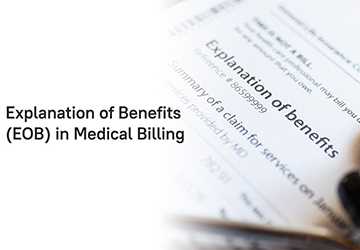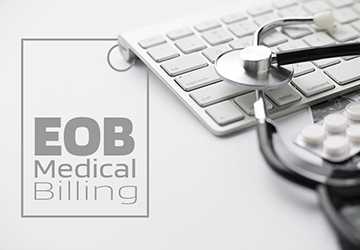What is an EOB (Explanation of Benefits) and How to Read It?
Have you ever received an envelope with a piece of paper labelled 'Explanation of Benefits' and needed clarification on what it is? Most of us are left wondering what the meaning of these forms our insurance companies present to us is.
Have you ever received an envelope with a piece of paper labelled 'Explanation of Benefits' and needed clarification on what it is? Most of us are left wondering what the meaning of these forms our insurance companies present to us is.
EOBs are filled with codes, numbers, and other terms laypeople could consider codes. But wait, there is more! Paying attention to them may prove costly.

Exemption billing mistakes or bill shock can catch you unawares if you need to know what to watch out for.
But do not worry; we have you covered.
This blog post will provide a general understanding of an EOB and how to decipher it like a pro. Say goodbye to the guesswork and the stress.
Are you as eager as we are to understand those confusing EOBs? Then, keep reading to learn more!
Why Understanding Your EOB Matters?
Nobody likes to think about it, but healthcare costs can be a real pain in the neck. The EOB is a secret weapon in addressing those expenses because you always have no control over them. It's not another receipt to stuff in a wallet or envelope or throw in the trash bin.
It would help to consider your EOB your financial navigator throughout your healthcare process. It tells you what services you received, what insurance you paid, and what you likely will have to pay. It's pretty handy.
But it gets better. This means you can identify any billing errors that may cause you an arm and a leg by going through your EOB keenly. Besides, you will gain a better understanding of how your insurance operates.
So, when you understand your EOB, you can make better decisions about your healthcare, not get caught off guard by a bill, and come out slightly ahead.
Well, the next time you receive that EOB in your mail, pay it the attention it deserves.
Breaking Down Your EOB: Everything You Must Know
Let's look at some of the specifics of your EOB. We'll explain the whole process quickly and one step at a time. You will handle these forms as if you were born with the skill.
Ready? Let's dive in.
Patient Information: Your Healthcare ID Badge
First things first! This means that you come first. Your EOB kicks off with your details, such as;
● Name
● Address
● Insurance ID number
● Group number (if applicable)
Why does this matter? Well, mistakes happen. An error in the name or an incorrect address may need clarification. Always double-check this section. If something needs to be corrected, call your insurance company.
Isn't it always the best policy to be better safe than sorry?
Service Details: The What, When, and Where
Below are the staples of your EOB – the services you received. This section is the healthcare logbook. It tells you:
● What service you got
● When you get it
● Who provided it
Here's a pro tip: compare this information with your notes. You know you saw Dr. Smith on March 15th, but are you sure you saw him on the same date? If you have any doubts, voice them out. Your pocket will feel lighter.
Charges and Payments: The Money Talk
Now, for the part most of us look forward to are the numbers. This section may seem like solving a math problem to some students. However, there is no need to stress. Here's what you'll see:
● Total charges: What your provider billed
● Allowed amount: What your insurance agreed to pay
● Amount paid: What your insurance forked over
● Your responsibility: The part that's coming out of your pocket
Your share can be a copayment or a deductible. When the figures are unequal, it is high time to ask questions like a detective would.
Remarks and Codes: Cracking the Code
Last but not least, we have the remarks and codes. These little numbers and letters may or may not be recognizable to some people, but it is all rather significant. They explain:
● Why a claim was denied
● What specific treatments have you received
● Any special notes about your coverage
Stay calm if you cannot decode these at the first glance. Almost all the EOBs are accompanied by a brief chart that helps the patient understand each code. If you are still trying to get through, the insurance company's website always provides the details of the rates in question.
Remember, knowledge is power. This implies that the more you're informed about your EOB, the better you deal with your healthcare expenses.
Here is some advice: take a deep breath, open the text, take a highlighter, and start deciphering. You've got this!
Take Control of Your Healthcare Costs Today!
You've learned how to control your healthcare costs. Do not let this knowledge go to waste! Begin by scrutinizing EOBs immediately; you could be in for a shock.

Remember Sarah from accounting? She noticed a $500 billing mistake by cross-checking the EOB. And Tom? He saved $1,200 last year merely by comprehending his coverage.
Be aware of your healthcare costs. Where others are bewildered, you will be sallying through your medical bills.
Pick up that EOB, employ the newly acquired knowledge, and be the master of your healthcare experience. Your pocket and mind will thank you!
Frequently Asked Questions
Q. How can I spot errors on my EOB?
Ans. Check the EOB with your records. Start with the statement, seek out new dates, services you never received, or incorrect personal data. If something needs to be clarified, always feel free to contact your insurance company or your healthcare provider.
Q. What should I do if I need help understanding the charge on my EOB?
Ans. First of all, read the remarks section to wonder why. If you still need clarification about the type of insurance coverage, you can always contact your insurance provider. They can identify the charges and inform the clients why specific amounts were not covered.
Q. Are EOBs the same as medical bills?
Ans. No, they're different. An EOB indicates the portion your insurance paid for and the amount you could be expected to pay. Your healthcare provider prepares a medical bill and depicts what you must pay.
Q. How often should I review my EOBs?
A: The patient should review each EOB as soon as they receive it. That way, some problems may be detected and corrected early, preventing them from escalating. Develop the habit, and you will be glad you did. It only takes a few minutes but will save a lot of time!